- Головна
- Готові шкільні презентації
- Презентація на тему «Pablo Picasso The founder of Cubism»
Презентація на тему «Pablo Picasso The founder of Cubism»
358
Слайд #1
Pablo PicassoThe founder of Cubism
Па́бло Піка́ссо
Основоположник кубізму
Па́бло Піка́ссо
Основоположник кубізму

Слайд #2
БіографіяBiography
Pablo Ruiz Picasso (Picasso Pablo) (1881-1973), Spanish painter and sculptor, in 1904, residing in France. Picasso - the inventor of new forms of painting, an innovator of styles and techniques, and one of the most prolific artists in history. Picasso created more than 20,000 works. Born in Malaga October 25, 1881.
Пабло Руис Пікассо (Picasso Pablo) (1881—1973), іспанський художник і скульптор, з 1904 року проживає у Франції. Пікассо – винахідник нових форм живопису, новатор стилів і методів, один із найбільш плодовитих художників в исторії. Пікассо создав більше ніж 20 тисяч робіт. Родився в Малазі 25 жовтня 1881 року.
Pablo Ruiz Picasso (Picasso Pablo) (1881-1973), Spanish painter and sculptor, in 1904, residing in France. Picasso - the inventor of new forms of painting, an innovator of styles and techniques, and one of the most prolific artists in history. Picasso created more than 20,000 works. Born in Malaga October 25, 1881.
Пабло Руис Пікассо (Picasso Pablo) (1881—1973), іспанський художник і скульптор, з 1904 року проживає у Франції. Пікассо – винахідник нових форм живопису, новатор стилів і методів, один із найбільш плодовитих художників в исторії. Пікассо создав більше ніж 20 тисяч робіт. Родився в Малазі 25 жовтня 1881 року.

Слайд #3
Пабло рано проявив талант до малювання. Уже з 7 років він учився у свого батька техніці малювання, який спочатку довіряв йому дописувать лапки голубів на своих картинах. Але одного разу, довіривши тринадцятилітньому Пабло дописать великий натюрморт, він був настільки вражений технікой сина, що, по легенді, сам кинув займатися живописсю.
Pablo showed early talent for drawing. Since 7 years he studied with his father's technique of drawing, which was initially commissioned him to finish writing the feet of pigeons in his paintings. But one day, entrusting thirteen Pablo finish pretty big still life, he was so struck by the technique of his son that, according to legend, he gave up painting.
Pablo showed early talent for drawing. Since 7 years he studied with his father's technique of drawing, which was initially commissioned him to finish writing the feet of pigeons in his paintings. But one day, entrusting thirteen Pablo finish pretty big still life, he was so struck by the technique of his son that, according to legend, he gave up painting.

Слайд #4
Голуб мируDove of peace
З 20 по 25 квітня 1949 року проходив I Всенародний конгрес сторонників миру в Парижі і Празі. Емблему конгреса намалював іспанский художник з французьким громадянством Пабло Пікассо. В 1950 році Пікассо був обраний у Всенародному совіті миру і нагороджений Міжнародною премією світу, в СРСР йому двічі вручали Ленінску премію.
From 20 to 25 April 1949 I passed the World Peace Congress in Paris and Prague. Emblem of the Congress drew a Spanish painter with French citizenship by Pablo Picasso. In 1950, Picasso was elected to the World Peace Council and was awarded the International Peace Prize, the USSR, he was twice awarded the Lenin Prize.
З 20 по 25 квітня 1949 року проходив I Всенародний конгрес сторонників миру в Парижі і Празі. Емблему конгреса намалював іспанский художник з французьким громадянством Пабло Пікассо. В 1950 році Пікассо був обраний у Всенародному совіті миру і нагороджений Міжнародною премією світу, в СРСР йому двічі вручали Ленінску премію.
From 20 to 25 April 1949 I passed the World Peace Congress in Paris and Prague. Emblem of the Congress drew a Spanish painter with French citizenship by Pablo Picasso. In 1950, Picasso was elected to the World Peace Council and was awarded the International Peace Prize, the USSR, he was twice awarded the Lenin Prize.
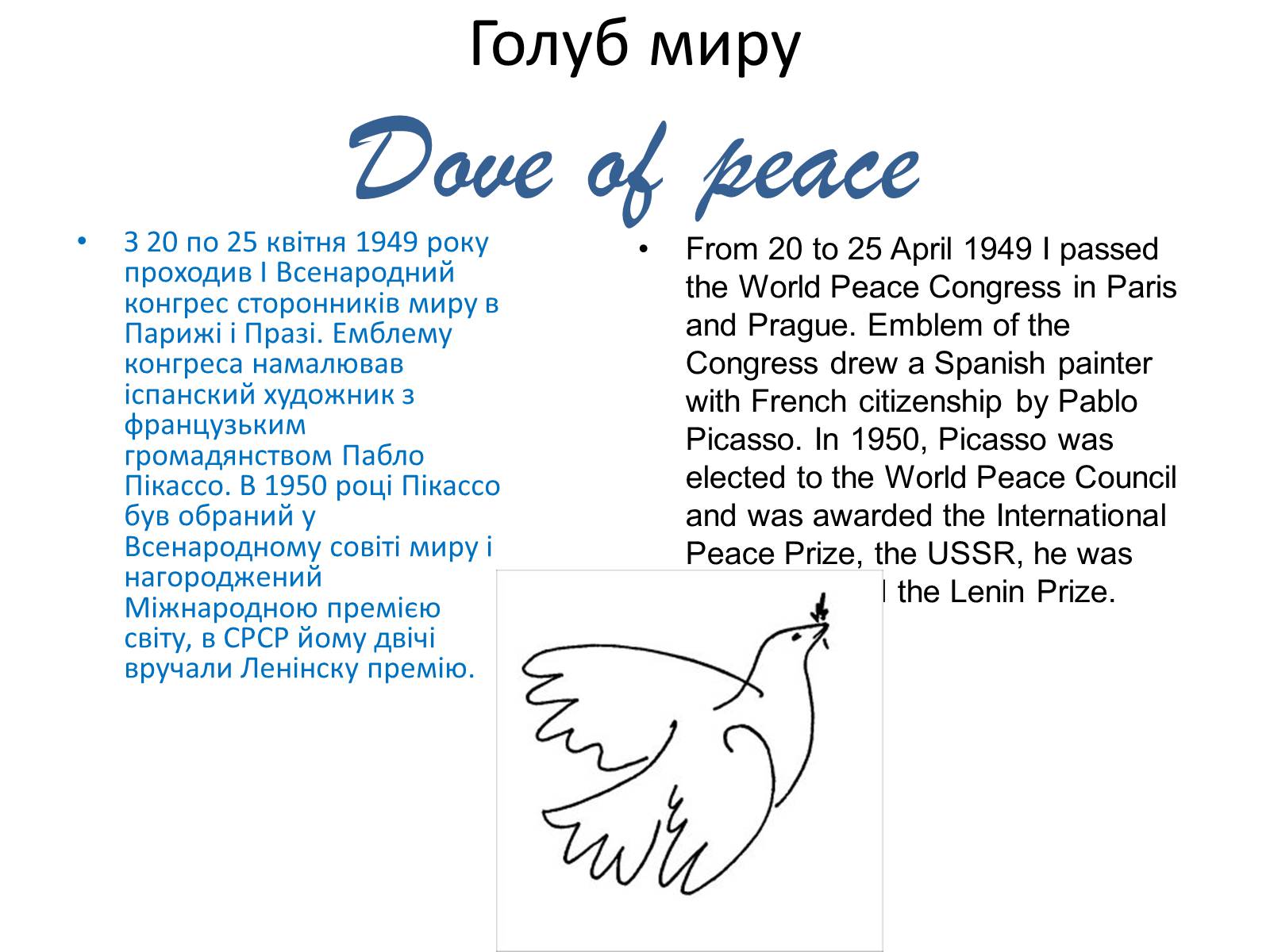
Слайд #5
Потрібно сказать, що Бог повністю обдарував одного із самих геніальних художників нашої сучасності Пабло Пікассо, відомого всьому світу не тільки своїми живописними роботами, графікой и скульптурой з керамиіки, але й багатьма романтичними відношеннями з представницями прекрасного полу. Одні з них були надзвичай бистроплинними, а другі ж — достатньо довгими. Але все в тій чи іншій степені показали вплив на його творчість.
I must say that God is wholly bestowed one of the most brilliant artists of our time: Pablo Picasso, known worldwide not only for his paintings, drawings and sculptures made of ceramics, but also set a romantic relationship with the fair sex. Some of them were too fleeting, and others - long enough. But all in varying degrees, influenced his work.
Жена Ольга с сыном
I must say that God is wholly bestowed one of the most brilliant artists of our time: Pablo Picasso, known worldwide not only for his paintings, drawings and sculptures made of ceramics, but also set a romantic relationship with the fair sex. Some of them were too fleeting, and others - long enough. But all in varying degrees, influenced his work.
Жена Ольга с сыном

Слайд #6
Блакитний періодBlue Period
На роки поїздок між Парижем и Барселоною (1901-04) приходиться так званий «блакитниий період»: в палітрі мастера перебільшують блакитні відтінки. Для картин цього періоду характерні образи бідняцтва, меланхолії і печалі ; пересування людей призупинені, вони ніби вслухаються в себе.
For years, traveling between Paris and Barcelona (1901-04) have so-called "blue period": the master of the palette is dominated by shades of blue. For paintings of this period is characterized by images of poverty, sadness and melancholy; flow of people slowed, they seemed to listen to how you.
На роки поїздок між Парижем и Барселоною (1901-04) приходиться так званий «блакитниий період»: в палітрі мастера перебільшують блакитні відтінки. Для картин цього періоду характерні образи бідняцтва, меланхолії і печалі ; пересування людей призупинені, вони ніби вслухаються в себе.
For years, traveling between Paris and Barcelona (1901-04) have so-called "blue period": the master of the palette is dominated by shades of blue. For paintings of this period is characterized by images of poverty, sadness and melancholy; flow of people slowed, they seemed to listen to how you.

Слайд #7
Розовий періодPink period
In the next period, known as "pink", there are scenes of friendship, admiring the beauty of the naked body.
Наступний період, називається «розовий», з'являются сцени дружби, любовання красотою голого тіла.
Хлопчик з конякою
In the next period, known as "pink", there are scenes of friendship, admiring the beauty of the naked body.
Наступний період, називається «розовий», з'являются сцени дружби, любовання красотою голого тіла.
Хлопчик з конякою

Слайд #8
Просту формуліровку основних цілей і принципів кубізма дати важко; в живописі можна виділить три фази цього направлення, відображаючих різні естетичні концепції, і продивитися кожну окремо: сезанський (1907-1909), аналітичний (1909-1912) и синтетичний (1913-1914) кубізм.
Simple language the basic purposes and principles of Cubism to a rather difficult, in painting, there are three phases of this trend, reflecting a different aesthetic concepts, and consider each separately: Cezanne (1907-1909), analytical (1909-1912) and synthetic (1913-1914 ) cubism.
Кубізм Cubism
Simple language the basic purposes and principles of Cubism to a rather difficult, in painting, there are three phases of this trend, reflecting a different aesthetic concepts, and consider each separately: Cezanne (1907-1909), analytical (1909-1912) and synthetic (1913-1914 ) cubism.
Кубізм Cubism
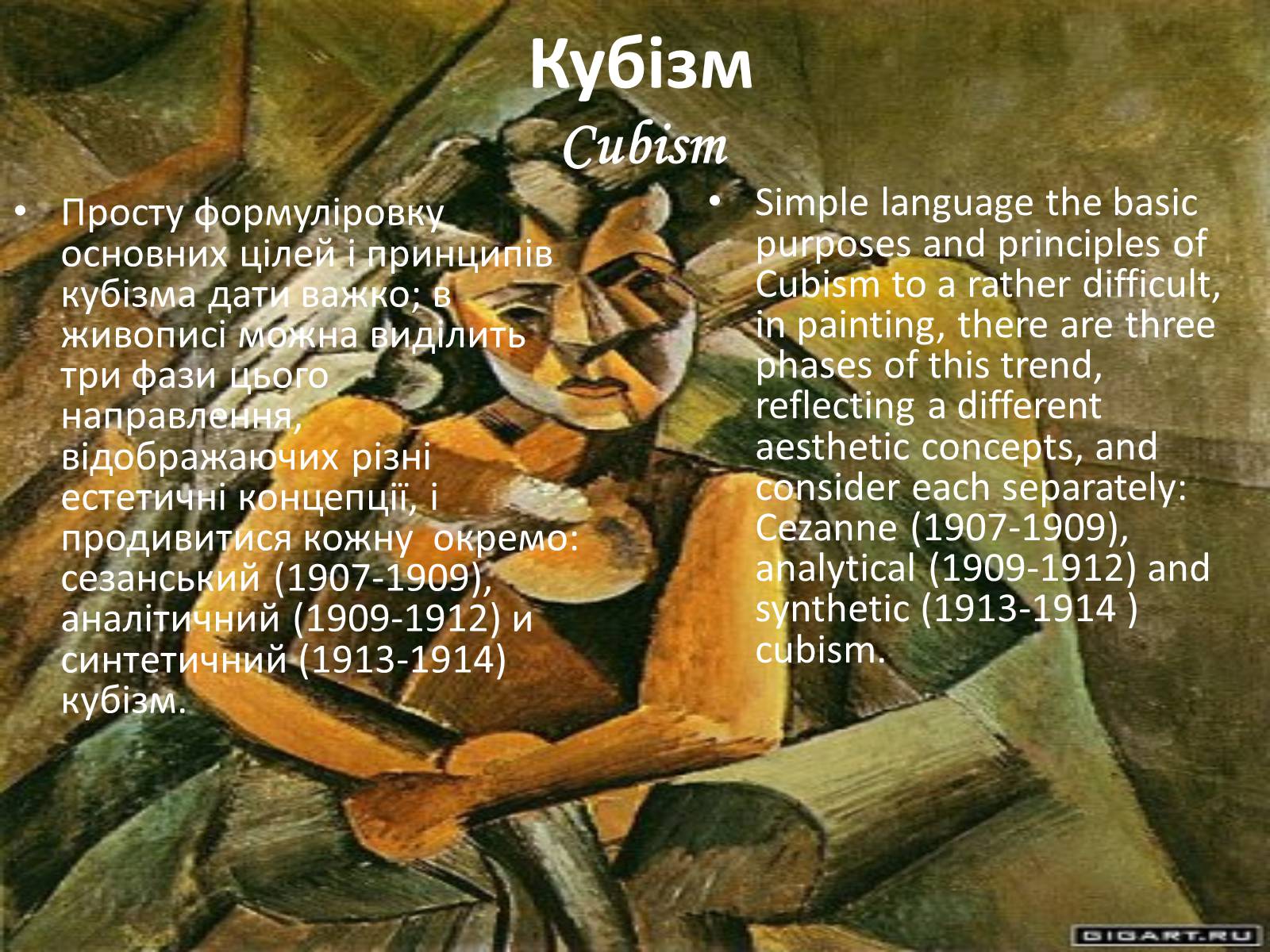
Слайд #9
Неокласицизм Neoclassicism
Весною 1917 року поет Жан Кокто, співпрацювавши з Сергієм Дягилевим, запропонував Пікассо зробить ескізи костюмів і декорацій до майбутнього балету. Художник відправився працювать в Рим, де влюбився в одну из танівниць Дягилевскої трупи - Ольгу Хохлову. Вони одружилися в 1918 году, а в 1921-м у них народився син Поль. В цей чвс його полотна дуже далекі від кубізма; на них: ясні і зрозумілі форми, світлого тону, правильні обличчя. Сама виразна картина тих років - "Портрет Ольги в кріслі" (1917). Пікассо активно критикували за зміну стиля, як раніше критикували за кубізм. На ці обвинувачення він відпові в одном з інтерв'ю: "Всякий раз, коли я хочу щось сказать, я говорю в тій манері, в якій, по-моєму відчутті це повинно бути сказано
In spring 1917 the poet Jean Cocteau, worked with Sergei Diaghilev, Picasso invited to make costumes and scenery to the future of ballet. The artist went to work in Rome, where he fell in love with one of the dancers in Diaghilev - Olga Khokhlova. They married in 1918 and in 1921 they had a son, Paul. At that time, his paintings are very far from cubism; on them: clear and understandable form, light tone, the right person. The most expressive picture of those years - "Portrait of Olga in an armchair" (1917). Picasso actively criticized for changing style, as in the past been criticized for cubism. On those charges, he said in an interview: "Whenever I want to say something, I say in the manner in which, in my sense it must be said."
Портрет Ольги
Весною 1917 року поет Жан Кокто, співпрацювавши з Сергієм Дягилевим, запропонував Пікассо зробить ескізи костюмів і декорацій до майбутнього балету. Художник відправився працювать в Рим, де влюбився в одну из танівниць Дягилевскої трупи - Ольгу Хохлову. Вони одружилися в 1918 году, а в 1921-м у них народився син Поль. В цей чвс його полотна дуже далекі від кубізма; на них: ясні і зрозумілі форми, світлого тону, правильні обличчя. Сама виразна картина тих років - "Портрет Ольги в кріслі" (1917). Пікассо активно критикували за зміну стиля, як раніше критикували за кубізм. На ці обвинувачення він відпові в одном з інтерв'ю: "Всякий раз, коли я хочу щось сказать, я говорю в тій манері, в якій, по-моєму відчутті це повинно бути сказано
In spring 1917 the poet Jean Cocteau, worked with Sergei Diaghilev, Picasso invited to make costumes and scenery to the future of ballet. The artist went to work in Rome, where he fell in love with one of the dancers in Diaghilev - Olga Khokhlova. They married in 1918 and in 1921 they had a son, Paul. At that time, his paintings are very far from cubism; on them: clear and understandable form, light tone, the right person. The most expressive picture of those years - "Portrait of Olga in an armchair" (1917). Picasso actively criticized for changing style, as in the past been criticized for cubism. On those charges, he said in an interview: "Whenever I want to say something, I say in the manner in which, in my sense it must be said."
Портрет Ольги

Слайд #10
Голова жінки

Слайд #11
Любитильниця абсенту
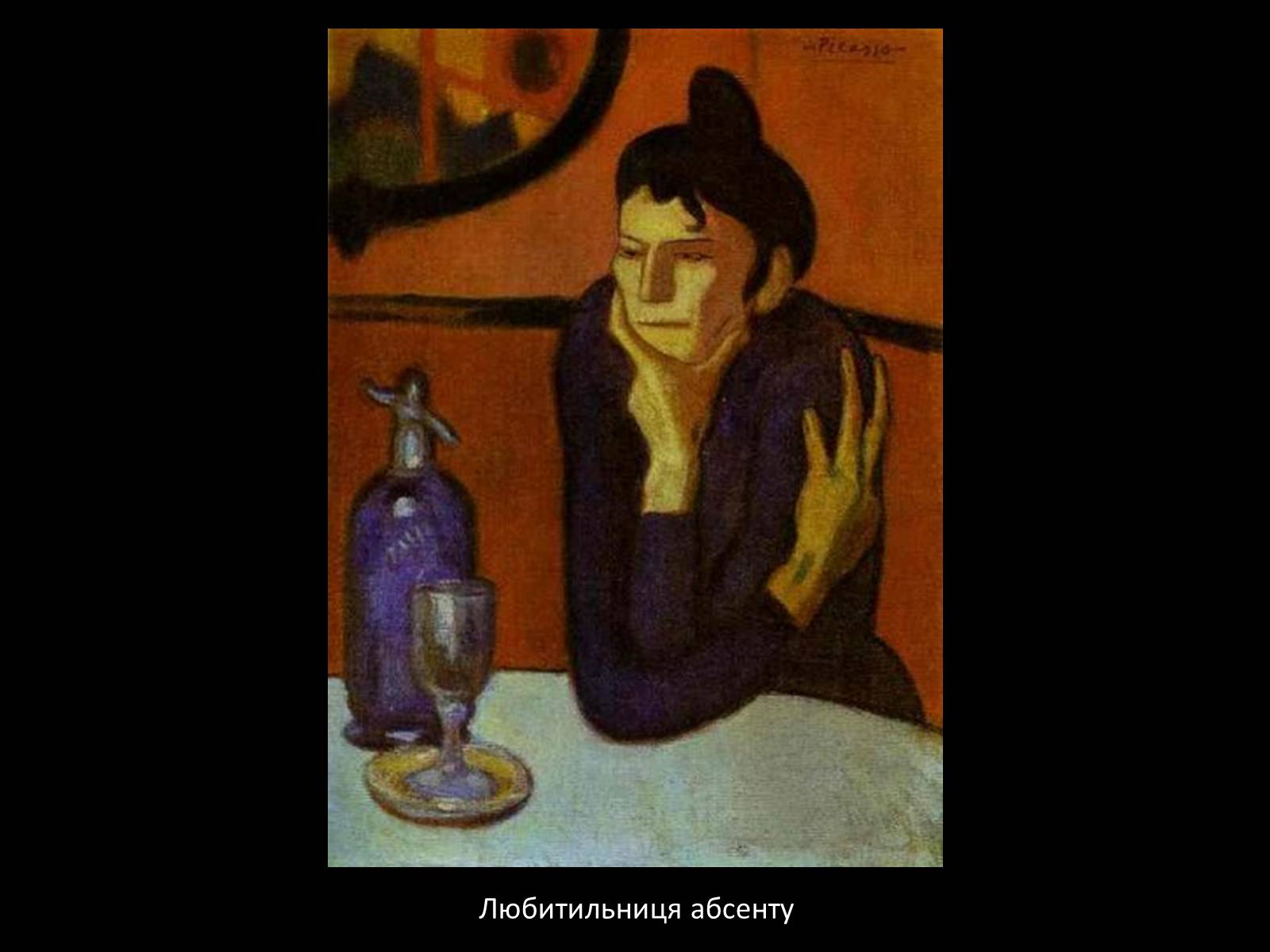
Слайд #12
Жінка з мандаліной

Слайд #13
Фігури на пляжі

Слайд #14
Герніка

Слайд #15
Авиньйонські дівиці

Слайд #16
Автопортрет
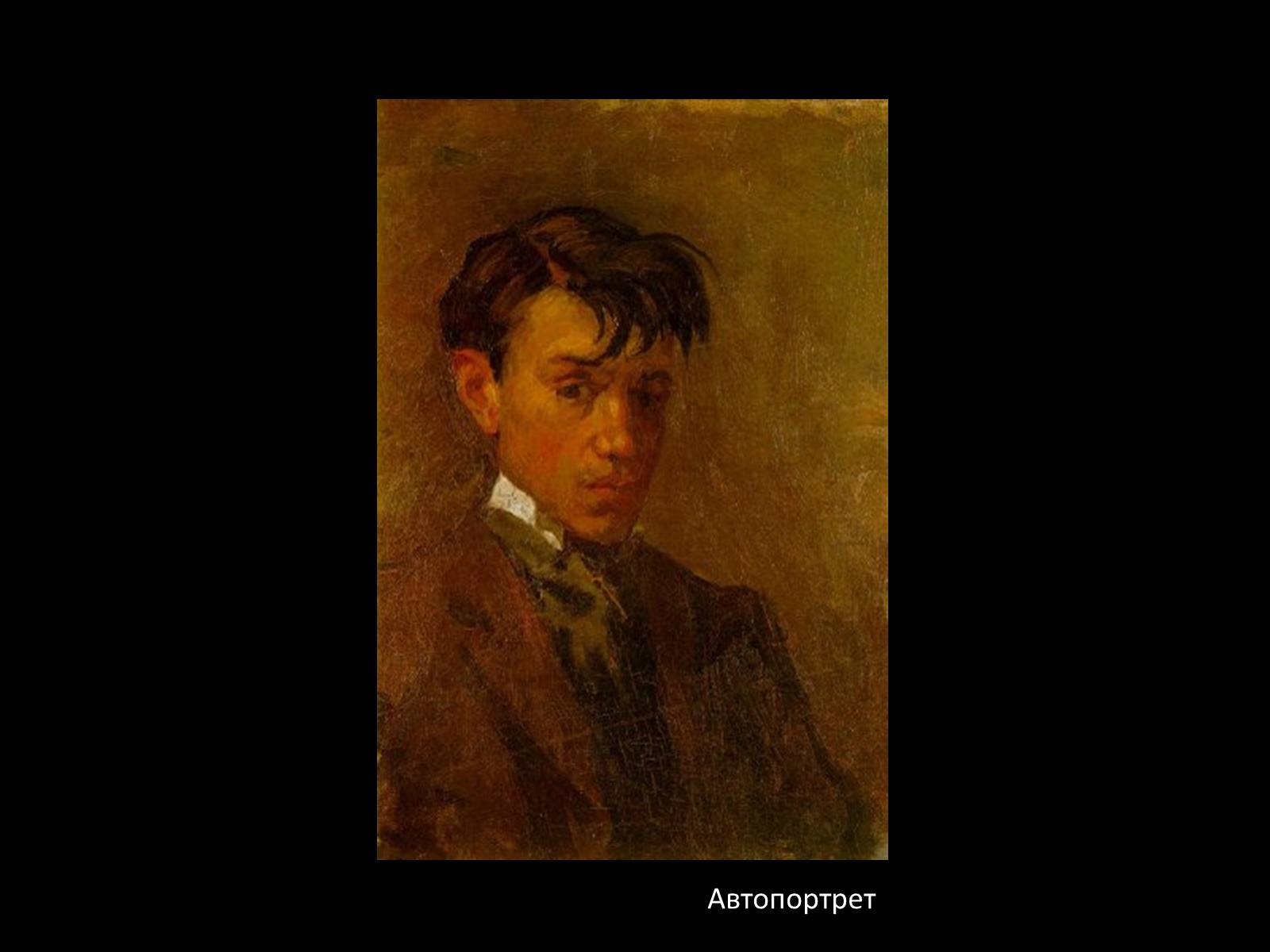
Слайд #17
Бутилка перно (столик в кафе)
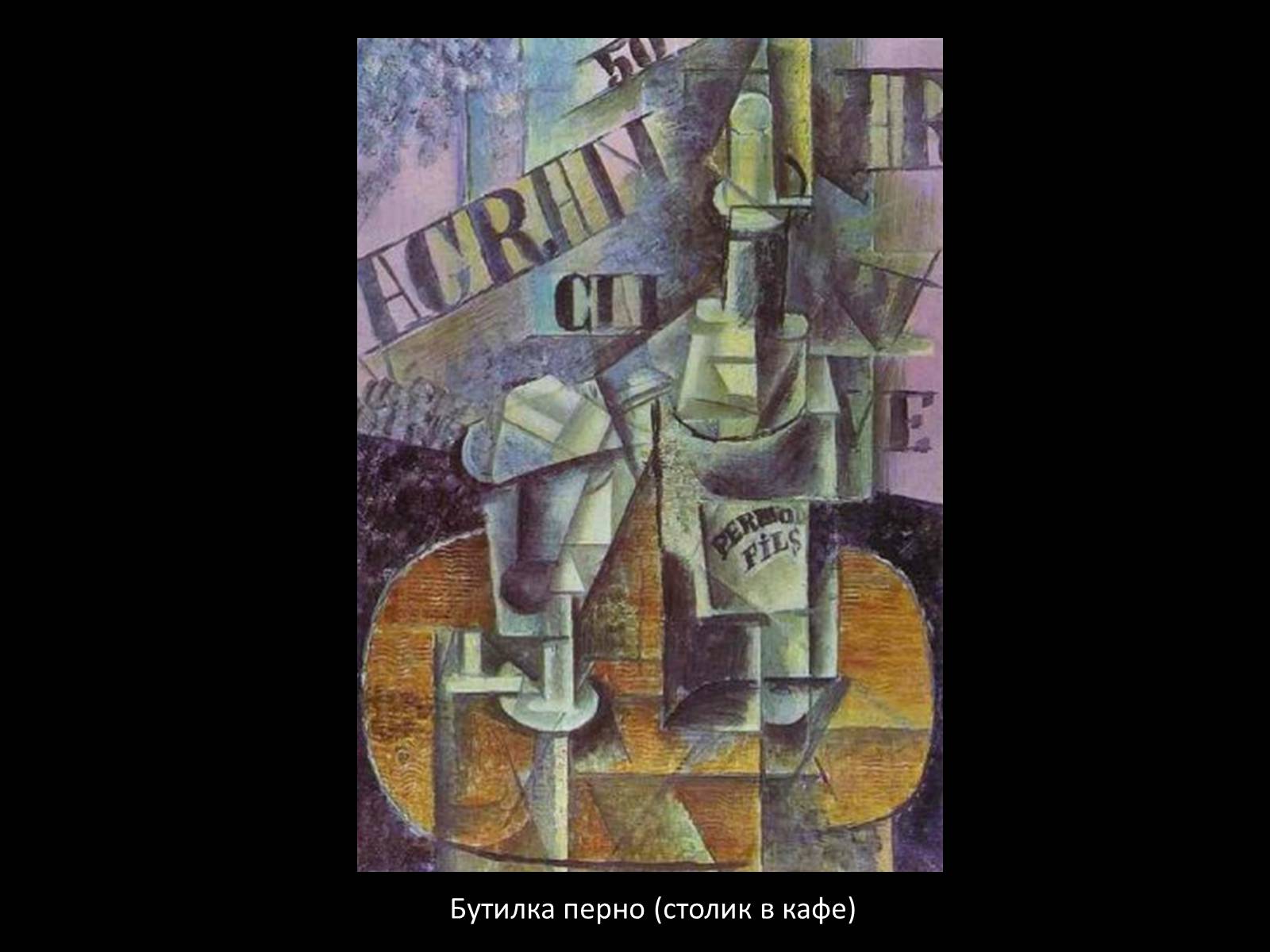
Слайд #18
Дівчина на кулі

Слайд #19
Жінка з квіткою

Слайд #20
Жінки бігають по пляжу

Слайд #21
Thank you for your attention!
